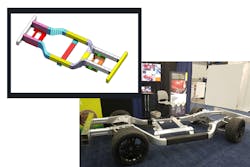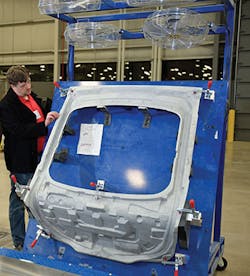Even if you’re not a car aficionado, you can see why the Chevy Corvette C2—aka the Stingray—is revered among the pantheon of American automotive manufacturing. Sleek. Classy. And fast. Really, really fast. It’s everything a muscle car should be. But what you can’t immediately see is how innovative and ahead of its time it was at its 1953 release.
Chevy made the Corvette body from fiberglass rather than steel—and the difference shows on the stopwatch. A 1967 model with a 427 engine could accelerate from 0 to 60 in 4.7 seconds. This has a lot to do with the V8 engine, but the lightweight design provides that extra performance edge. It’s basic physics: Lighter vehicles require less power to move them faster. For Chevy, and any other automaker, it’s also basic economics.
“Once you reach a certain horsepower level, it gets very expensive to add more power, whereas to take the weight off, it’s generally less expensive,” says Gregory E. Peterson, principal materials engineer for the Michigan Manufacturing Technology Center, a consulting organization that helps manufacturers improve profits and performance.
The MMTC and Peterson were asked in 2017 to find a lighter alternative to the C2’s steel frame for the aftermarket sector, and produced a composite frame comprising ultra high-strength steel, aluminum, magnesium and carbon fiber. It weighs 33% (or 89 lb.) less. The frame is also 450% stronger.
The 30-plus-year veteran, who himself has a Stingray sitting in his garage, previously worked on lightweighting projects at General Motors, Chrysler and most recently Lotus Engineering, where he says a popular maxim was: “To add speed, add lightness.”
And the thing about gearheads is they always want to go faster, which means always want to get lighter, too. The amount of fiberglass in the Corvette has given way to more complex, even lighter composite materials. At the extreme end, there’s the Formula One engineers, creating basically missiles on wheels that can rocket to 62 mph in about 1.7 seconds and weigh less than 2 tons. They’re so good at lightweighting they have a minimum weight of 1,618 lb.
At the other end of the spectrum, there are the amateurs with a more low-tech way of lightweighting. I knew a guy who removed the backseats from his Ford Escort ZX2 to gain a speed advantage against other Escort drivers (which back then in the early 2000s was considered an achievement for some reason). And the theory was right on, despite clumsy execution.
Peterson points to the lightweighting rule that a 10% weight reduction leads to a 6% to 7% increase in fuel economy.
But there are easier ways to make cars lighter nowadays than removing key components of a vehicle. Instead, these parts are changing in shape and composition, blending various metals and carbon fiber reinforced plastic, relying on next-gen design software and techniques such as additive manufacturing.
And because of the mass-compounding effect, Peterson explains, when the structure becomes lighter, other elements do as well, from the suspension to the brakes to the tires.
That’s why lightweighting has become something of an obsession for the industry. And while the early Corvettes, heralds of this new age, were designed for speed, more and more the drive is for better fuel economy (see recent France riots), or more recently increased range on an electric vehicle. For some it might be because you want to reduce your carbon footprint, but more likely because governments around the world are demanding it.
Whatever the reason, lightweighting has become a top priority of carmakers. The materials and high-tech engineering previously reserved for the Grand Prix can now be had by car owners looking to upgrade from their old Pontiac Grand Prix to a more fuel-efficient car or EV. And while the math might be fairly simple to work out, even professional automotive engineers have not yet mastered execution, either.
“In terms of where we’re at with lightweighting today, it’s very incremental,” says Peterson. “They’re being quite conservative.”
That’s all about to change, as manufacturers can no longer settle for dainty little bunny hops of improvements when the C-Suite, investors and end-users want their hair knocked back by disruptive efficiency gains. They see the CAFE standards getting more stringent, electric vehicles becoming more prevalent, and gas prices in constant flux. At best, lightweighting could potentially reduce vehicle mass by half and boost fuel efficiency by 35%. That’s dramatic; it will take a lot of work.
Out of necessity, the industry is throwing all of its experience (and its weight) into making lighter vehicles. Innovations in metallurgy, material science and 3D-printing are leading the acceleration. Keeping track of them can be difficult, as the speed of this innovation can be on par with those F-1 cars, so we spoke with experts in each of the major lightweighting areas to discuss the leading solutions and how they are driving changes from incremental to incredible.
Not-So-Heavy Metals
Aluminum provides a 40% to 45% mass improvement over steel. In 2015, Ford began making its bestselling F-150 pickup truck body out of aluminum, lightening it by 700 lb.
“The problem is the cost of implementing those materials,” says Alan Taub, the CTO at the LIFT (Lightweight Innovations for Tomorrow) Consortium, a public-private partnership of universities, manufacturers and the U.S. Navy’s Office of Naval Research. Traditional carbon steel is currently priced around $0.40/lb., and aluminum more than doubles carbon steel’s price at $0.88.
LIFT, part of the Manufacturing USA network, exists to find the right lightweight materials and way to implement them in the subsequent manufacturing processes. And the solution must be applicable to at least two industries. They work on transferring innovations found in the lab to the OEMs and Tier 1s who can enact real change. The initiative is as much about economics as it is about metallurgy.
“You want to get in the range of about $2 incremental cost for every pound saved,” Taub explains. “If you’re not in the range of [at least] $2 to $2.50 per pound saved, it’s really not a good value for the customer and there are other technologies you can do.”
This would mean focusing on the engine or aerodynamics, for example. Taub says aluminum sheet now falls within this range, as does the third generation of advanced high-strength steel. The World Steel Association (WSA) says AHSS comprises as much as 60% of new auto bodies, and can reduce weight by 25%-39% over conventional steel. Aluminum has less mass than AHSS, but is weaker and is more expensive. An MIT study calculated in 2007 that aluminum structures were 60%-80% more expensive. That was when aluminum was $1.22/lb., though.
AHSS seems to have the edge in emissions when comparing well-to-wheel scores. A life cycle assessment model by the WSA found that AHSS reduced at best 6,600 lb. of CO², while aluminum was 3,300. Even though aluminum is lighter, that reduction equaled a savings of about a third-tank of gas annually. That doesn’t mean aluminum isn’t a viable option.
“Recycling of aluminum is one-tenth of the energy of getting it out of ground and there’s a lot available,” says Peterson, who works in the same building in Detroit as Taub and supports LIFT’s efforts on behalf of NIST.
He mentions magnesium, used in that Corvette, as an up-and-coming metal. It costs $2.10/lb. but can reach up to 60% in weight savings.
The real solution from LIFT’s perspective will be found when the perfect combination of these metals (and plastics and carbon fiber) are implemented. In each scenario they first tinker with the array of prospective materials to create optimal strength, safety and fuel economy. Then they have to ensure the different metals don’t negatively interact. Taub says galvanic corrosion can occur if water gets in between two different metals. This happened with the Statue of Liberty in the 1980s, when her copper exterior and wrought iron supports came into contact after the insulation failed. It required a massive restoration with stainless steel supports. LIFT found a special coating on the multi-metal parts will suffice.
The Corvette frame, which will be commercialized by a low-volume manufacturer in Michigan, used continuous bonds with structural adhesives, while being 450% stiffer in bending, is easier to manufacture, and requires inexpensive tooling and minimal labor, the MMTC says.
High (Carbon) Fiber Diet
“Carbon fiber has the best potential for lightweighting, but takes a lot of energy,” says Ray Boeman, Institute for Advanced Composites Manufacturing Innovation (IACMI) Scale-Up Research Facility (SURF) Director. IACMI is also based in the same building in Detroit’s Corktown neighborhood as LIFT and focuses on making carbon fiber feasible.
Carbon fiber is 55% lighter than carbon steel and can be ten times stronger, but the limiting factor is cost. Despite the price, which could be up to $500/lb., aerospace manufacturers value the performance above all. Half of the Airbus A350 XWB airliner’s total weight is carbon fiber reinforced plastic. Formula One, where expense always comes in a distant second to performance, also relies heavily on the material.
A new low-cost carbon fiber is down to $5/lb., says Lawrence Drzal, Director of the Vehicle Technical Application Area at IACMI. Drzal and his team are now figuring out how to attain the high throughput the auto industry needs. A Boeing or Airbus can take several hours to create one part. The goal is to reach 90 seconds to make a carbon fiber lift gate or hood.
First, a mold must be made and the operator puts the fibers in dry, arranging them in the correct geometry for shape and load bearing, and aligned for the maximum force. Then they close the mold and inject the epoxy at high speed.
The cycle time is limiting CFRP at BMW. The i3 and i8 hybrid sports cars had been made out of CFRP and could get up to 76 mpg, but the new iNext cars produced in Dingolfing, Germany, where the cycle times are 60 seconds, will revert back to a metal frame, adding CFRP at strategic spots.
“Automotive is always looking to cut pennies,” Boeman says. “You don’t need as high performance. They are sort of bookends. We’re trying to move each of those ends closer to the middle and adopt some modified lightweight aerospace systems and figure out how to take out cost.”
ResearchAndMarkets.com predicts the carbon fiber industry will be worth about $6.1 billion in 2023, more than double the 2017 value, and that could reach the hundreds of billions. But for wide use, the auto industry will need a monumental upshift in skilled labor that can manipulate the carbon fiber.
“The education of people involved in the manufacturing has to be broadened,” Drzal says. “Traditionally, you pick up sheet metal, put it in a press, open it and take out the part. With composites, you’re concerned with how the fibers are aligned, the thermoset system like epoxy, temperature, and the time exposed to that temperature to achieve the properties you want.
A New Generation of Design
“EVs are going to be the driver for a revolution rather than evolution,” says Peterson.
According to the International Energy Agency, the EV market will reach between 125 million and 220 million by 2030, spurred by growing concerns over human-induced climate change.
“Climate change is real,” wrote GM CEO Marry Barra in May. “We recognize the transportation sector is a contributor, and we must be part of the solution. At General Motors, we take this challenge seriously. It’s a driving force behind our vision of a future with zero crashes, zero emissions and zero congestion.”
It was also a driving force on why GM recently announced a restructuring that will displace 8,100 employees and potentially shutter five plants in North America. GM wants to have 20 models of electric or fuel-cell powered cars out by 2023, and the current model isn’t set up to accommodate that change.
With such a paradigm shift, GM is also rethinking every part of its products, tossing out all preconceived notions of what design should look like.
Why does a seat belt bracket look the way it does? Because of machining requirements. But what if machining was replaced by additive manufacturing?
A revolutionary new approach GM starts with is Autodesk’s generative design software, an engineering software tool that uses artificial intelligence and cloud computing to manifest dozens to hundreds of possible models based on physical requirements. For a bracket, it must attach at certain lengths and support specific loads, but the AI knows a 3D printer can create any shape, no matter how wild, so it eliminates material that was sub-optimized only for the manufacturing process, explains Kevin Quinn, GM Director of Additive Design and Manufacturing.
“You unhinge yourself from those constraints with generative design,” Quinn says. “It opens up a whole new set of lightweighting opportunities that we have based on designs we can’t make any other way.”
The end result is a stainless-steel bracket that looks more like a human knee, smoother with ligament-like supports, as opposed to a robust, square shape comprised of eight welded pieces. The new version is also 40% lighter and 20% stronger.
This generative design approach is even being applied to the materials themselves, Taub says.
It involves the Material Genome Initiative, an intra-governmental effort started in 2011 to deploy advanced materials in manufacturing at twice the rate for a “fraction of the cost.”
“It’s the equivalent of modifying DNA, but we’re modifying the processing of the metal to give us the right crystal structure,” Taub said. Then work is done to have it make sense for manufacturing.
He calls the approach “Atoms to Autos.” It’s similar to CRISPR modifying DNA, but with elements at the atomic level, powered by more powerful supercomputing. This allows for a new level of generative design, but with specific materials.
“We optimize the form and distribution of those phases, and we’re doing it now not by Edisonian trial and error, we’re doing it with the tools for quantum mechanics calculations to determine the right materials to add and how to process them,” he explained. “We can fabricate and evaluate at a small scale 20 materials combinations in the time it took for one.”
Taking all this into account, the next generation of automotive designers could theoretically type in the simple engineering and cost parameters for a brake system, and their AI program could generate thousands of options depending on various alloys mixed with more or less titanium or aluminum, or decide carbon fiber would work.
If and when this becomes commonplace in automotive manufacturing, the only place on a car the quaint notion of incremental change will be is the rear-view mirror.








